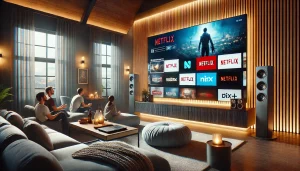Introduction
Over the past ten years, the film industry has experienced tremendous change, mostly due to shifts in consumer behavior and technological improvements. With the rise of Over-The-Top (OTT) platforms, the traditional theater experience is being challenged like never before. This article explores the advantages and disadvantages of both OTT vs Theatre Film Industry, analyzes their impact on the film industry, and examines which format may define the future of cinema.
Differences Between OTT and Theaters

OTT (Over-the-Top) platforms and theaters provide different ways to watch movies, each with unique benefits. OTT platforms allow viewers to watch movies and shows from home or on the go, offering flexibility and convenience. Theaters, on the other hand, give a special experience with a large screen and surround sound, making movie-watching feel grand and immersive.
OTT is often cheaper, with a single subscription providing access to many films and series. Theaters can be more expensive per movie, especially when factoring in ticket costs, snacks, and transportation. Additionally, theaters offer a social experience, letting audiences enjoy the movie together, while OTT is mostly a private viewing experience.
The Rise of OTT Platforms

Over-The-Top (OTT) platforms, such as Netflix, Amazon Prime Video, and Disney+, have revolutionized how audiences consume content. By delivering films and shows directly to viewers via the internet, these platforms provide convenience and accessibility that traditional theaters cannot match. OTT services allow users to watch films anytime and anywhere, making it easier for busy lifestyles to fit in entertainment.
Advantages of OTT Platforms

- Accessibility: OTT platforms are accessible to anyone with an internet connection. This broadens the potential audience for films, allowing creators to reach viewers who may not have access to theaters.
- Diverse Content: These platforms often host a wide variety of films, including independent projects that might not find a place in traditional theaters. This diversity enriches the viewing experience and gives filmmakers more opportunities to showcase their work.
- Cost-Effectiveness: Subscribing to an OTT service is typically more affordable than buying multiple movie tickets, making it an attractive option for families and individuals on a budget.
Disadvantages of OTT Platforms

- Screen Experience: Watching movies at home lacks the immersive experience of a theater, where large screens and surround sound create a unique atmosphere.
- Quality Control: The vast content available on OTT platforms can lead to uneven quality. Some films may not receive the same level of production and marketing as those released in theaters.
- Social Experience: Watching films in theaters is often a communal experience, where audiences share reactions and emotions. OTT viewing can be isolating, diminishing the social aspect of film-watching.
The Convenience of OTT Platforms

OTT platforms have made watching movies more convenient than ever. People can watch their favorite films or shows from the comfort of their homes at any time. All they need is an internet connection and a subscription, which is often affordable. This flexibility allows viewers to pause, rewind, or even rewatch movies as they please. For those with busy schedules, OTT platforms are an ideal choice because they make it easy to enjoy entertainment without having to plan around theater showtimes.
Variety of Content on OTT

OTT platforms offer a vast range of films and shows that include international, independent, and niche genres. This diverse selection gives audiences the chance to explore content they may not find in theaters. Since OTT platforms are always expanding their libraries, viewers can discover fresh content regularly. Filmmakers, too, benefit from OTT’s wide reach, as they can showcase stories that might not appeal to the traditional theater crowd. This variety is a major reason why OTT platforms have become so popular.
The Enduring Appeal of Theaters

Despite the rise of OTT, theaters continue to hold a significant place in the film industry. Many filmmakers still prefer the theatrical release for its potential to generate revenue and create buzz around their films.
Advantages of Theatrical Releases

- Enhanced Experience: The theater experience, with its large screens and high-quality sound systems, offers an unparalleled way to enjoy films, especially blockbusters with stunning visuals and soundtracks.
- Cultural Significance: The tradition of going to the movies is deeply ingrained in many cultures. The theater provides a venue for community gatherings and shared experiences.
- Revenue Potential: Successful films can generate significant box office revenue, which is often crucial for studios and filmmakers. A successful theatrical release can lead to increased demand for home media and streaming rights.
Disadvantages of Theatrical Releases

- Cost and Accessibility: Going to the theater can be expensive, especially for families or larger groups. Additionally, theaters may not be easily accessible in some regions, limiting potential audiences.
- Limited Screen Time: Films typically have a limited run in theaters, meaning that if viewers miss the initial release, they might have to wait for digital release or streaming.
- Competition: The theater experience competes with a growing number of entertainment options at home, such as gaming and streaming, which can draw audiences away from theaters.
The Immersive Experience of Theaters

Theater screens are large, with advanced sound systems that make movies more immersive. This setup creates an experience that home screens can’t quite match, especially for big-budget movies with impressive visuals and sound. In theaters, the focused environment helps viewers escape from daily distractions. For many, the feeling of being part of a shared audience, laughing or gasping together, adds an extra layer of enjoyment to the film-watching experience. This communal aspect is one of the theater’s biggest advantages.
Future Trends in the Film Industry

As we look to the future, it is evident that both OTT and theater formats will coexist, each catering to different audiences and preferences. The film industry may continue to evolve, finding innovative ways to blend the two formats. For example, some films are now being released simultaneously in theaters and on OTT platforms, allowing audiences to choose their preferred viewing method.
Industry Predictions
- Hybrid Releases: We may see more films adopting hybrid release strategies, combining theater and OTT launches to maximize audience reach and revenue.
- Enhanced Theater Experiences: To compete with OTT, theaters may invest in enhancing the viewing experience through advanced technology, premium seating, and unique offerings such as dining options.
- Increased Collaboration: Partnerships between OTT platforms and traditional studios will likely grow, allowing for a wider array of films to be produced and distributed across both channels.
Comparative Table: OTT vs Theater
| Feature | OTT Platforms | Theater Releases |
|---|---|---|
| Accessibility | High; available globally with internet connection | Moderate; location-dependent |
| Cost | Generally lower; subscription-based | Higher individual ticket costs |
| Content Diversity | Extensive; includes independent, international, and niche content | Limited; mostly mainstream and high-budget films |
| Convenience | Watch anytime and anywhere | Fixed showtimes and locations |
| Viewing Experience | Home comfort with standard screens and speakers | Immersive with large screens and surround sound |
| Social Engagement | Private or small group viewing | Shared, communal experience |
| Revenue Model | Subscription and ad-based | Box office sales, concessions |
| Content Control | More control over content choices | Limited options, based on show schedule |
| Audience Reach | Broad; easily accessible globally | Region-specific, often limited by theater locations |
| Impact on Industry | Disruptive; encourages diverse content creation | Traditional; maintains blockbuster culture |
Analysis Table: Pros and Cons of OTT and Theater
| Aspect | OTT Platforms (Pros) | OTT Platforms (Cons) | Theater (Pros) | Theater (Cons) |
|---|---|---|---|---|
| Accessibility | Accessible anywhere with internet | Limited by internet availability and data costs | Universal, with presence in urban areas | Inaccessible in remote areas |
| Viewing Flexibility | Watch anytime; pause, rewind, and rewatch options | Limited immersion due to home distractions | Immersive, with focused viewing | Fixed schedules; no replays |
| Content Variety | Wide range, from indie films to blockbusters | Quality varies; not all films receive high production | Premium-quality films shown | Mostly limited to mainstream releases |
| Cost | Subscription packages affordable | Monthly fee, additional charges for rentals | Tickets support local economy | Can be expensive for families and large groups |
| Social Experience | Private or small group viewing | Lack of shared audience reactions | Strong community feel and shared reactions | Inconvenient for solo viewers |
| Revenue Generation | Steady subscription revenue and targeted ads | Smaller revenue per film compared to theaters | High revenue potential from ticket and concession sales | Risky; success heavily depends on box office |
| Cultural Impact | Expands access to diverse and international films | Less communal; isolated viewing experience | Deeply rooted cultural experience | Decreasing interest among younger audiences |
| Environmental Impact | Lower carbon footprint; less physical infrastructure needed | Internet streaming contributes to energy use | Jobs and local economy support through theaters | Requires more energy for large-scale operations |
Conclusion
The debate between OTT platforms and traditional theaters is ongoing, with both sides offering unique benefits and challenges. As technology and consumer habits continue to evolve, it is crucial for industry stakeholders to adapt and innovate. The future of the film industry may not be defined by one format alone but rather a combination of both, creating a richer and more diverse landscape for audiences worldwide.












